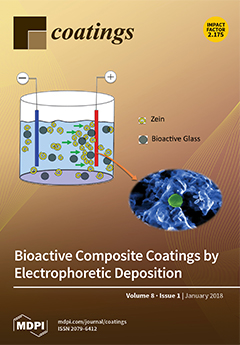In this study, Mo-Cu-V-N composite coatings with high Cu content of ~18 at.% were deposited on 316L stainless steel and YT14 cemented carbide substrates by high power impulse magnetron sputtering in Ar–N
2 gas mixtures. The influence of N
2 partial pressure was
[...] Read more.
In this study, Mo-Cu-V-N composite coatings with high Cu content of ~18 at.% were deposited on 316L stainless steel and YT14 cemented carbide substrates by high power impulse magnetron sputtering in Ar–N
2 gas mixtures. The influence of N
2 partial pressure was investigated with respect to the microstructure and tribological properties of the coatings. The results indicated that the Mo-Cu-V-N composite coatings exhibited FCC B1-MoN phase with a strong (200) preferred orientation, and Cu phase was found to exist as metallic species. As the N
2 partial pressure increased from 0.11 to 0.35 Pa, the peak intensity of (200) plane decreased gradually and simultaneous peak broadening was observed, which was typical for grain refinement. With increasing the N
2 partial pressure, the columnar microstructure became much coarser, which led to the decrease of residual stress and hardness. The Mo-Cu-V-N composite coatings with high Cu content exhibited a relatively low wear rate of 10
−8 mm
3/N·m at 25 °C, which was believed to be attributed to the mixed lubricious oxides of MoO
2, CuO and V
2O
5 formed during tribo-oxidation, which cannot be formed in the coatings with low Cu content. When the wear temperature was increased up to 400 °C, the wear rate increased sharply up to 10
−6 mm
3/N·m despite the formation of lubricious oxides of MoO
3/CuMoO
4 and V
2O
5. This could be due to the loss of nitrogen and pronounced oxidation at high temperatures, which led the wear mechanism to be transformed from mild oxidation wear to severe oxidation wear.
Full article





